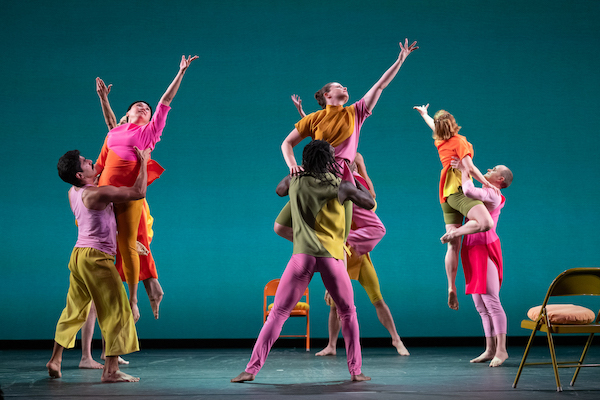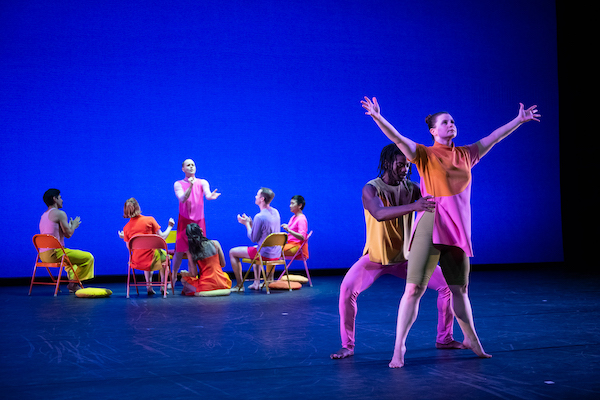Dance Review: The Mark Morris Dance Group Presents “The Look of Love”
By Charles Giuliano
Given the infectious and embracing music of Burt Bacharach and Hal David, Mark Morris’s The Look of Love will most likely be regarded as among his most accessible and popular dances.

The Mark Morris Dance Group performing The Look of Love. Photo: Christopher Duggan
After a two-year hiatus (Covid and renovations) the renowned Jacob’s Pillow in Becket, Massachusetts, launched its summer season with an hourlong suite, The Look of Love, by the Mark Morris Dance Group. America’s oldest and most respected dance festival runs for nine weeks ending on August 27. Performances run Wednesday through Sunday.
The venerable Ted Shawn Theatre looked the same, yet refreshed. Having sweated out a number of performances, the new AC was much enjoyed. For the first time the theater contains an orchestra pit. It was put to immediate use with a seven-piece band (four instruments and three vocalists) led by pianist Clinton Harris. In addition to piano, bass, and drums there was a trumpet, which tended to dominate the sound, making it a bit too brassy. Another instrument would be welcome.
A score of 13 songs, music by Burt Bacharach, lyrics by Hal David, has been arranged by Ethan Iverson for 10 dancers. Bacharach’s first hit, 1958’s “The Blob,” was written for a campy horror film (now a cult item) starring Steve McQueen. There was suitably spooky lighting by Nicole Pearce, but this was an odd fit in the program’s mix of readily familiar hits.
Several of the program’s songs were written for Dionne Warwick, with whom the composer had a productive relationship until a falling out in 1972. Her sultry, laid back, understated vocal style served the complexity of his songs splendidly. Bacharach’s music is characterized by unusual chord progressions, influenced by jazz harmony, with striking syncopated rhythmic patterns, irregular phrasing, frequent modulation, and odd, changing meters.

The Mark Morris Dance Group performing The Look of Love. Photo: Christopher Duggan
More than most contemporary choreographers, who reach across a variety of genres and styles, Morris focuses on critical analysis — he tends to deconstruct the music. What may often appear to be quirky movements are not arbitrary: they are visual articulations of nuances in the score. This approach calls for audiences to be active participants in the performance — they have to use all of their senses to appreciate the dance. For example, bird-like fluttering of arms made no narrative sense, but synched with Bacharach’s quick rhythmic flourishes.
The series of sold-out Pillow performances represent the East Coast premiere of the work. Bacharach attended a performance several months before his demise at 94 last February.
The evening commenced with a piano solo of “Alfie.” I could hear the lyrics from the 1966 film, starring Michael Caine, in my head. It was a prelude to the curtain parting for an anthem tune “What the World Needs Now,” which has never felt more relevant.
The five male and five female dancers circled with connected hands, then partnered with turns and soft lifts. There was a wash of pastel colors (pink, yellows, apple green) in tunics, dresses, tights, and shirts designed by longtime Morris collaborator Isaac Mizrahi.

The Mark Morris Dance Group performing The Look of Love. Photo: Christopher Duggan
Love lost and gained is a power theme in the music of Bacharach/David. Morris details, with deft power, these shifts of anguish and yearning.
You can’t miss the gesture of rejection in “I’ll Never Fall in Love Again.” A lithe, tall woman pushes off from a lover and becomes cocooned in herself. Morris can often be literal, but he is never simplistic. He brings this drama to a conclusion that is neither easy nor obvious.
In “Walk on By” the dancers emphatically marched, eyes front, back and forth across the stage. That awkward moment of a chance encounter with a former lover is universal.
I had to do some research to unravel the interpretation of the now iconic Warwick version of “Message to Michael.” It was originally “Letter to Martha” and written for a male voice. Initially, Bacharach/David rejected her bid to record it, which she did in France. Initially released as a B side, it was aired in New Orleans, which the song references, and the version took off.
Morris uses pastel folding chairs and cushions as props. Seated and then standing, a dancer, surrounded by listeners or followers, lip-syncs the lyrics while a couple performs an anguished love scene center stage. There was humor along with the heartbreak. In “Raindrops Keep Falling on My Head” the puddle-hopping dancers used pillows as “umbrellas.”

The Mark Morris Dance Group performing The Look of Love. Photo: Christopher Duggan
Warwick was particularly missed during the quick, abrupt shifts of the rhythmic “Do You Know the Way to San Jose” and the iconic “Walk on By.” In these cases singer Marcy Harriell didn’t adequately evoke Warwick or supply a fresh interpretation. Of course, that’s a tough assignment. Consider, for example, how Diana Ross bombed as Billie Holiday but Audra McDonald utterly nailed her version.
Starting in the ’80s with Dance Umbrella in Boston, then Tanglewood, and now Jacob’s Pillow, we have seen more performances by the Mark Morris Group than any other American company. Some might even recall Morris in a silver top hat and tails performing solo on stage at Emerson/ Majestic. His movements were fluid, expressive, and often amusing. It is hard not to channel the movements of his dancers through that memory. Morris’s training is rooted in ballet, classical, and folk dance. Whatever the music, his distinctive vocabulary and style is about reinvigorating the familiar.
While the dancers in The Look of Love have moments in which they are featured, there are no virtuoso soloists. They are intricate pieces of a puzzle that fit enjoyably together, an ensemble that Morris pointedly identifies as a “group” rather than a“company.” The performance ended on a whimsical note, with the breathy and evocative “I Say a Little Prayer.” It left me and no doubt others feeling hungry for more.
With his sister, Charles Giuliano has just published his eighth book, Annisquam: Pip and Me Coming of Age.
Tagged: Burt Bacharach, Hal David, Isaac Mizrahi, Mark-Morris, The Look of Love

What a fantastic review!